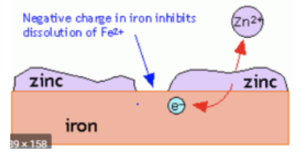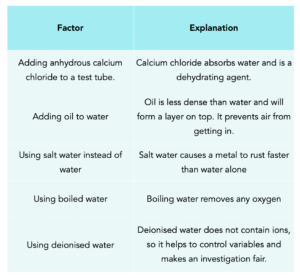Corrosion & Prevention (GCSE Chemistry)
Corrosion & Prevention
Corrosion
Rusting of Iron
- Corrosion is a chemical reaction. Corrosion can destroy metals using chemical reactions. The surface of the metal will react with substances in the environment, causing it to corrode.
- Rusting is an example of corrosion. An example of corrosion is the rusting of iron. Iron corrodes very easily, to form iron (III) oxide. Rust flakes off the iron, exposing a new layer of iron to undergo the same process.
- Rusting requires oxygen and water. In order for iron to rust, oxygen and water are required. Both of these can be found in the air.

Preventing Corrosion
- Protective coatings prevent corrosion. To stop metals from corroding, a protective coating can be applied to them as a barrier to water and oxygen. This coating can be done by greasing with oil, painting or electroplating with a different metal.
- Electroplating works by the process of electrolysis. Electrolysis allows a thin layer of metal to be placed on the object. At the cathode is the object and at the anode is the plating metal. The electrolyte is made up of ions of the plating metal.
- Aluminium oxide protects aluminium. Aluminium oxide is a coating on aluminium. This oxide layer on the surface of aluminium prevents further corrosion from affecting the metal.
- Electroplating has different uses. Electroplating reduces the risk of metals being exposed to corrosion or damage. It also improves the aesthetic and appearance of metals, for example in silver plated cutlery.
Sacrificial Protection
- Coatings can be reactive. Sometimes, reactive metals can be used as coatings to protect other metals. The coating will be more reactive than the metal it is covering.
- Sacrificial protection uses a reactive metal. In the sacrificial protection method, a more reactive metal is used as a coating. This more reactive metal will be corroded by oxygen and water, in the place of the less reactive metal.
- Zinc can galvanise iron. Coating iron with zinc is an example of the sacrificial method. The zinc will be corroded as opposed to the iron. This specific method is called galvanisation.

Experimental Evidence
In order to understand the effects of oxygen and water on iron, we can do an experiment.
- Place iron nails into boiling tubes. In this experiment, we place 3 iron nails in 3 separate boiling tubes.
- Place different substances into boiling tubes. One boiling tube contains the nail alone without any air or water. The second tube contains the nail, water and then a layer of oil to prevent air getting in. The third boiling tube contains the nail, air and water.

Understanding different factors in experimental conditions. A number of other factors could be investigated. The table summarises the effect of possible factors.
FAQs
Corrosion is a chemical reaction that occurs when a metal comes into contact with an oxidizing agent such as oxygen, water or acid. This reaction results in the deterioration of the metal, leading to damage and potentially even failure.
The different types of corrosion include uniform corrosion, localized corrosion, galvanic corrosion, and intergranular corrosion.
Corrosion can be prevented by using coatings such as paint or a layer of oil to protect the metal, using alloys that are less reactive than the base metal, using cathodic protection, and controlling the environment through proper ventilation or dehumidification.
Cathodic protection is a technique used to prevent corrosion by making the metal the cathode in an electrochemical cell, which involves connecting the metal to a sacrificial anode that corrodes instead of the metal.
An example of uniform corrosion is the rusting of iron due to exposure to water and oxygen.
An example of localized corrosion is pitting corrosion, which is caused by a localized breakdown in the protective coating, leading to the formation of small pits or holes in the metal.
An example of galvanic corrosion is the corrosion of a metal in contact with a more noble metal in the presence of an electrolyte, such as saltwater.
An example of intergranular corrosion is the corrosion of the grain boundaries in a metal due to exposure to high temperatures or corrosive environments.
The environment can contribute to corrosion by providing the oxidizing agents such as oxygen or moisture that cause the chemical reaction to occur.
Alloys can be used to prevent corrosion by choosing an alloy that is less reactive than the base metal, creating a barrier that prevents the oxidizing agent from coming into contact with the metal.
Preventing corrosion is important because it can lead to structural damage, decreased safety, and the need for costly repairs or replacement of the metal.





Still got a question? Leave a comment
Leave a comment